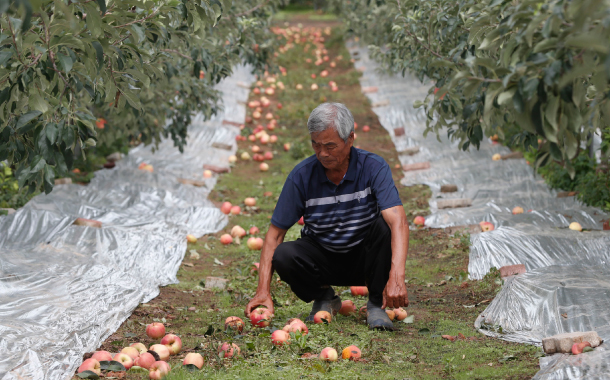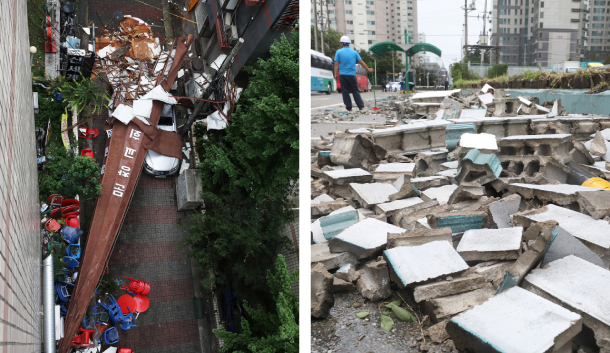Typhoon kills 3, damages farms

An apple farmer in Yesan County, South Chungcheong, grieves over his damaged crops on Sunday morning, five days before the gift-sharing holiday of Chuseok, after Typhoon Lingling passed Korea’s west coast Saturday, bringing gale-force winds and rain. [NEWS1]
Seoul experienced strong winds that damaged trees, buildings, store signs and utility poles and even toppled a church steeple.
After passing through North Korea on Saturday evening, the typhoon lost strength as it crept towards Russia Sunday morning, South Korea’s weather agency said. It was not immediately known how much North Korea was affected, but the regime’s state media reported damages to houses, buildings, trees and utility poles, without specifically mentioning any casualties or death.
According to the South’s Central Disaster and Safety Countermeasures Headquarters, a 75-year-old woman died in Boryeong, South Chungcheong; a 39-year-old man died in Incheon; and a 61-year-old man died in Paju, Gyeonggi.
Authorities said the 75-year-old was killed when she climbed onto the roof of her warehouse to check on damages, only to get knocked off by strong wind and fell on her neighbor’s garden wall. The 39-year-old who died in Incheon was a bus driver. He parked his bus in a parking lot near the back gate of Inha University Hospital and stepped out of the vehicle when a brick wall nearby suddenly collapsed and landed on him. The driver was sent to the hospital but died while receiving medical treatment.
The 61-year-old in Paju was killed by a roof that flew off a structure.

Left, a steeple of a church in Dobong District, northern Seoul, was blown down on Saturday and landed on a car. Nobody was injured. Right, a part of a brick wall separating Inha University Hospital and a Hanjin Global Logistics building in Incheon collapsed Saturday, killing a bus driver. [NEWS1]
The state power provider, Korea Electric Power Corporation (Kepco), said some 162,000 households across the country experienced blackouts Saturday, and almost all had their electricity restored by Sunday morning. A spokesperson from Kepco advised people not to touch damaged electric wires and report to the organization if they see any, citing the possibility of electrocution.
With just five days left until the gift-sharing holiday of Chuseok, many farmers grieved over their damaged agricultural lands.
Local authorities tallied at least 7,145 hectares (17,655 acres) of farmlands affected by the typhoon, including 4,253 hectares of rice paddies where rice plants were destroyed. Various types of fruits across 1,157 hectares of orchards were damaged, and so were vinyl greenhouses on areas that added up to about 42 hectares.
The Ministry of Agriculture, Food and Rural Affairs, however, said the typhoon’s impact on sales for the Chuseok harvest festival, which runs from Thursday to Saturday, would not be great because the most popular products given as gifts - including apples, pears, beef, pork, chicken, jujubes and chestnuts - had mostly already been processed and dispatched for sale because this year’s Chuseok came early.
At least 500 trees along public streets were toppled by Typhoon Lingling, including 485 in North Jeolla, 50 in North Chungcheong and 30 on Jeju Island.
By Saturday evening, the Cultural Heritage Administration tallied at least 21 cases of damage to cultural assets, including nine state-authorized assets. A fir tree that was believed to be 250 years old snapped and fell to the ground at Haein Temple in Hapcheon County, South Gyeongsang. Another natural monument in Hwasun County, South Jeolla, a gingko tree, had its branches snapped off by the wind, as did a silver magnolia tree on Gwanmae Island of Jindo County, South Jeolla.
In Jeju, a blackout caused some 22,000 halibut to die on a fish farm after their oxygenators went off, and 500 pigs on a farm died after their fans were forced to stop. At least 35 fishing boats in Jeju and South Jeolla that were moored in ports capsized, and seven farming facilities for marine products were damaged. In Daegu, a glass wall on the exterior of a department store was torn off and fell to the ground.
Twenty-one national parks including Mount Seorak, Mount Bukhan and Mount Naejang were declared off limits on Saturday but re-opened for hikers the next morning. At the international airports of Incheon, Gimpo in western Seoul and Cheongju in North Chungcheong, 71 international flights were canceled on Saturday along with 161 domestic flights. At ports in Masan in South Gyeongsang and Mokpo and Yeosu in South Jeolla, 165 ferries were canceled. From 1 p.m. to 4:40 p.m., subway services in Seoul were slower than usual for trains above ground.
The Korea Meteorological Administration (KMA) said Sunday that the entire country will experience rainfall this afternoon from a low-pressure system moving north from the Yellow Sea. The rain will stop tonight in Jeju, Tuesday morning in the southern areas and Tuesday afternoon in the central regions including Seoul and Gyeonggi, the KMA predicted.
In North Korea’s case, a South Korean government official who spoke on the condition of anonymity Sunday said local authorities believe areas located on the eastern side of the typhoon’s eye experienced the most damages over the weekend, indicating the provinces of North Hwanghae, South Hwanghae, Kangwon, South Pyongan, North Hamgyong and South Hamgyong, most of which are areas known as North Korea’s breadbasket.
North Korean media did not specify damages to its farmlands, but the state-run Korean Central TV aired video footage that showed roads in those areas inundated, raising fears that Typhoon Lingling could worsen the North’s food crisis.
The United Nation’s Food and Agriculture Organization and World Food Programme said in an annual report in May that food crop production in North Korea last year was its lowest level since 2008, forcing ration cuts for 10.1 million people who are in “urgent need of food assistance.” The assessment was made by the two organizations from two on-site visits to the North in November and April, following Pyongyang’s request for humanitarian aid.
A separate report by UN food agencies released in July said nearly half of North Korea’s population was undernourished from 2016 to 2018.
BY LEE SUNG-EUN, KANG CHAN-SU AND JEONG YONG-SOO [lee.sungeun@joongang.co.kr]










with the Korea JoongAng Daily
To write comments, please log in to one of the accounts.
Standards Board Policy (0/250자)